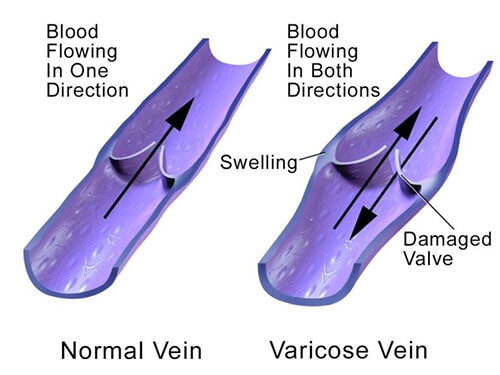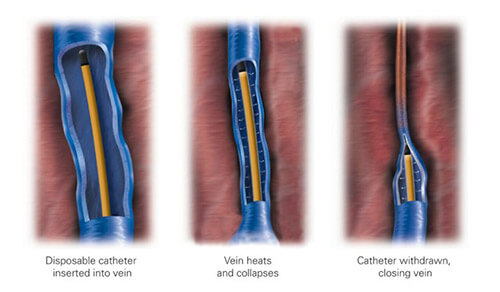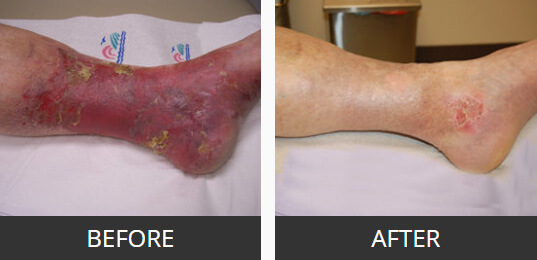Venous Ulcers
What Are Venous Stasis Ulcers?
Venous stasis ulcers develop in individuals with the most advanced stage of venous reflux disease. They are the most common cause of lower extremity ulcers, and are notoriously stubborn and painful, typically taking months to heal without proper care. These wounds are prone to frequent recurrences until the underlying cause gets treated. Even after healing with compression therapy and preventative wound care, these therapies cannot do the trick alone. They may help to maintain symptoms but do not address the medical condition that contributes to ulcer formation, which is often venous reflux disease.
Today’s thermal therapies with radiofrequency (Venefit) and laser (EVLT) treatments target venous reflux disease and provide rapid relief by healing venous stasis ulcers- for good.
Millions of women and men throughout the world suffer from this medical condition and may experience a range of symptoms in the sensation and appearance of their legs. These symptoms range from visible varicose veins to discomfort in the legs, leg achiness and swelling, restless legs, and more.
Venous reflux disease develops over time and generally becomes increasingly worse and debilitating if not treated, as with the occurrence of venous stasis ulcers.
Common Risk Factors For Venous Ulcers
- Age
- Family history / genetics
- Immobility
- Obesity / weight fluctuation
- Smoking
- Trauma to the affected area
- Visible varicose veins
- Discomfort in the legs (achiness, itching, numbness)
- Restless legs
- Leg swelling
- Skin discoloration

The longer that venous reflux disease remains in the superficial venous system, the more painful and debilitating it can get. Venous stasis ulcers form as malfunctioning vein valves and or diseased vein walls prevent blood flow, and allow blood in veins to leak downward in the wrong direction towards the foot. This creates venous hypertension, causes further breakdown in the vein wall and valves and leads to excessive inflammation and skin tissue breakdown in the affected area. These venous states eventually produce skin changes (darkening, dermatitis, fibrosis) and open sores/wounds (ulceration) around the mid-thigh and or ankles. Venous stasis refers to the state of the vein, in which blood pools in the veins of the lower leg, particularly around the ankles.
Early detection and treatment are key to achieving quick symptomatic and cosmetic relief from the discomfort, ulcers and visible varicose veins brought on by venous reflux disease.
Venous Ulcer Treatment
Our board-certified surgeons successfully treat venous ulcers with a comprehensive approach to correct the underlying problem of leakage in the veins (venous reflux) and help to heal the active wound on the skin surface with a regimen of wound care, compression therapy and medication. Conservative measures alone, such as wound care and compression, cannot heal venous stasis ulcers for the long term. Treatment of venous reflux disease is necessary to bring complete relief to the pain, debilitation and appearance of venous ulcers. Upon consultation and a thorough, non-invasive evaluation of the deep and superficial vein systems, we can understand your circulation and determine which veins are culprit. This allows our vascular specialists to decide how to best treat the problem veins. Non-surgical thermal therapies bring relief quickly as they help to re-direct blood flow away from the affected area, correcting the leakage in the veins. Patients note continuous improvement in how their legs feel after treatment and will see resolution of open sores and related skin changes and discoloration over time. We generally avoid surgical intervention, such as stripping and endoscopic perforator ligation (SEPS).
How it Works

Thermal therapies with radiofrequency (Venefit) and laser (EVLT) deliver heat energy to the refluxing veins via a tiny catheter or laser fiber inserted into the vein, using ultrasound guidance for visualization and precision. The heat causes collagen contraction within the vein wall, which forces the vein shut. The treated vein gets reabsorbed by the body over time, and blood flow that initially passed through this area naturally re-directs itself through the superficial venous system into healthier veins. Venous ulcers will resolve over time as blood begins to circulate properly through the area and skin tissue heals. Patients note improvement in leg sensations like achiness, itching and restlessness a few days after treatment with ongoing, incremental improvement.
Because this treatment is only performed on superficial veins that do not carry significant amounts of blood flow, there is a reduced risk for any complications once the vein is sealed. In addition, sealing the affected vein dramatically improves the appearance of the varicose vein without negatively affecting major circulatory functions.
Our specialists perform the entire procedure right in our office, typically in less than an hour. They apply localized anesthetic to the treatment area and assure that you remain comfortable throughout the procedure. Patients tolerate radiofrequency and laser treatment very well. Our vein specialists may require ongoing wound- and compression- therapy during the course of treatment for optimal results, fast recovery and maximum leg comfort.
What Results Can You Expect?
Like many patients who suffer from venous ulcers, our patient above presented with a non-healing venous stasis ulcer of the medial ankle at the Wound Center and received conservative therapy with medical-grade compression stockings. He underwent an ultrasound exam which showed significant venous reflux disease in his superficial venous system. We treated him with the ClosureFAST procedure which corrected the underlying venous issue that contributed to his ankle wounds, reduced peri-wound pressure in the affected area, and allowed for complete healing. Follow up visits at 1, 3 and 6 month intervals showed continuous improvement in the treated area. Patient reported significant improvement in the feeling and appearance of his legs. The one- year post-operative report shows a closed wound and improvement in venous stasis discoloration in his legs as well.
Getting Started
No one needs to suffer from non-healing venous ulcers. Northwest Vein & Aesthetic Center offers therapies that make it easier than ever to start addressing wounds today! Meet with our board-certified vascular surgeons and learn more about your treatment options.
MOST INSURANCE PLANS COVER RADIOFREQUENCY AND LASER (EVLT) TREATMENT. We also accept CareCredit financing.
References:
Management of venous leg ulcers: clinical practice guidelines of the Society for Vascular Surgery and the American Venous Forum. O’Donnell TF et al. J Vasc Surg. 2014 Aug;60(2 Suppl):3S-59S
Chronic venous insufficiency. Eberhardt RT, Raffetto JD. Circulation. 2014 Jul 22;130(4):333-46

